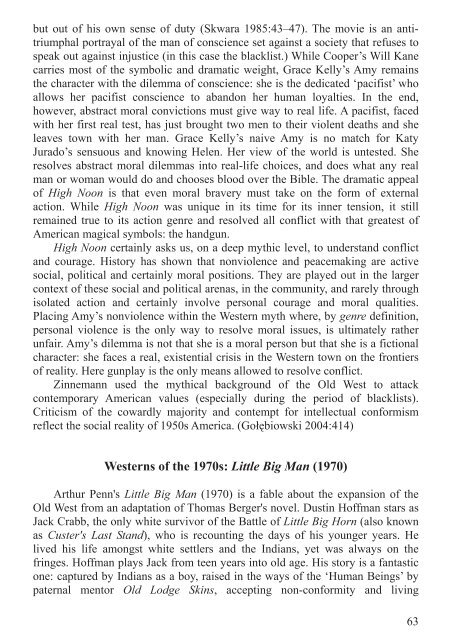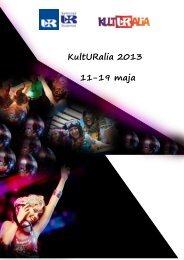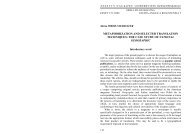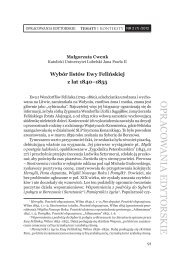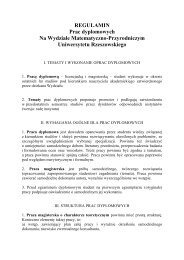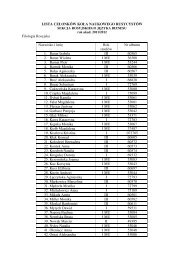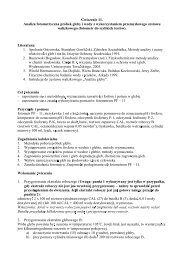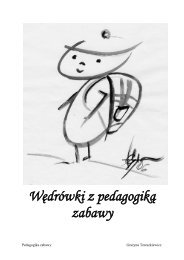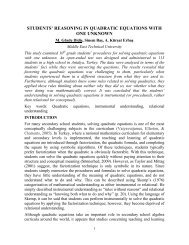the evolution of the western genre resulting from social changes in ...
the evolution of the western genre resulting from social changes in ...
the evolution of the western genre resulting from social changes in ...
Create successful ePaper yourself
Turn your PDF publications into a flip-book with our unique Google optimized e-Paper software.
ut out <strong>of</strong> his own sense <strong>of</strong> duty (Skwara 1985:43–47). The movie is an antitriumphalportrayal <strong>of</strong> <strong>the</strong> man <strong>of</strong> conscience set aga<strong>in</strong>st a society that refuses tospeak out aga<strong>in</strong>st <strong>in</strong>justice (<strong>in</strong> this case <strong>the</strong> blacklist.) While Cooper’s Will Kanecarries most <strong>of</strong> <strong>the</strong> symbolic and dramatic weight, Grace Kelly’s Amy rema<strong>in</strong>s<strong>the</strong> character with <strong>the</strong> dilemma <strong>of</strong> conscience: she is <strong>the</strong> dedicated ‘pacifist’ whoallows her pacifist conscience to abandon her human loyalties. In <strong>the</strong> end,however, abstract moral convictions must give way to real life. A pacifist, facedwith her first real test, has just brought two men to <strong>the</strong>ir violent deaths and sheleaves town with her man. Grace Kelly’s naive Amy is no match for KatyJurado’s sensuous and know<strong>in</strong>g Helen. Her view <strong>of</strong> <strong>the</strong> world is untested. Sheresolves abstract moral dilemmas <strong>in</strong>to real-life choices, and does what any realman or woman would do and chooses blood over <strong>the</strong> Bible. The dramatic appeal<strong>of</strong> High Noon is that even moral bravery must take on <strong>the</strong> form <strong>of</strong> externalaction. While High Noon was unique <strong>in</strong> its time for its <strong>in</strong>ner tension, it stillrema<strong>in</strong>ed true to its action <strong>genre</strong> and resolved all conflict with that greatest <strong>of</strong>American magical symbols: <strong>the</strong> handgun.High Noon certa<strong>in</strong>ly asks us, on a deep mythic level, to understand conflictand courage. History has shown that nonviolence and peacemak<strong>in</strong>g are active<strong>social</strong>, political and certa<strong>in</strong>ly moral positions. They are played out <strong>in</strong> <strong>the</strong> largercontext <strong>of</strong> <strong>the</strong>se <strong>social</strong> and political arenas, <strong>in</strong> <strong>the</strong> community, and rarely throughisolated action and certa<strong>in</strong>ly <strong>in</strong>volve personal courage and moral qualities.Plac<strong>in</strong>g Amy’s nonviolence with<strong>in</strong> <strong>the</strong> Western myth where, by <strong>genre</strong> def<strong>in</strong>ition,personal violence is <strong>the</strong> only way to resolve moral issues, is ultimately ra<strong>the</strong>runfair. Amy’s dilemma is not that she is a moral person but that she is a fictionalcharacter: she faces a real, existential crisis <strong>in</strong> <strong>the</strong> Western town on <strong>the</strong> frontiers<strong>of</strong> reality. Here gunplay is <strong>the</strong> only means allowed to resolve conflict.Z<strong>in</strong>nemann used <strong>the</strong> mythical background <strong>of</strong> <strong>the</strong> Old West to attackcontemporary American values (especially dur<strong>in</strong>g <strong>the</strong> period <strong>of</strong> blacklists).Criticism <strong>of</strong> <strong>the</strong> cowardly majority and contempt for <strong>in</strong>tellectual conformismreflect <strong>the</strong> <strong>social</strong> reality <strong>of</strong> 1950s America. (Gobiowski 2004:414)Westerns <strong>of</strong> <strong>the</strong> 1970s: Little Big Man (1970)Arthur Penn's Little Big Man (1970) is a fable about <strong>the</strong> expansion <strong>of</strong> <strong>the</strong>Old West <strong>from</strong> an adaptation <strong>of</strong> Thomas Berger's novel. Dust<strong>in</strong> H<strong>of</strong>fman stars asJack Crabb, <strong>the</strong> only white survivor <strong>of</strong> <strong>the</strong> Battle <strong>of</strong> Little Big Horn (also knownas Custer's Last Stand), who is recount<strong>in</strong>g <strong>the</strong> days <strong>of</strong> his younger years. Helived his life amongst white settlers and <strong>the</strong> Indians, yet was always on <strong>the</strong>fr<strong>in</strong>ges. H<strong>of</strong>fman plays Jack <strong>from</strong> teen years <strong>in</strong>to old age. His story is a fantasticone: captured by Indians as a boy, raised <strong>in</strong> <strong>the</strong> ways <strong>of</strong> <strong>the</strong> ‘Human Be<strong>in</strong>gs’ bypaternal mentor Old Lodge Sk<strong>in</strong>s, accept<strong>in</strong>g non-conformity and liv<strong>in</strong>g63


